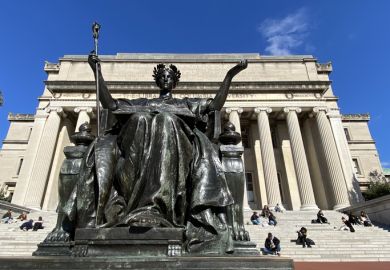Source: Getty
‘Academically, the sky hasn’t fallen in’
Since Australia made the decision to abolish caps on student numbers for bachelor’s degrees in 2009, it has barely looked back.
Uncapping was part of a bold reform package inspired by the 2008 Bradley review, aimed at increasing participation, improving equity and applying more stringent regulation to academic standards.
The Labor government of the day embraced the review’s argument for the creation of a more highly skilled workforce via a more responsive, competitive, higher education system. The demand-driven system, as it came to be known, began working immediately, at least in market terms.
Universities started enrolling above their caps to grab market share, even though government funding for unlimited student enrolment did not begin until 2012. Unmet demand began to evaporate as students in the middle band of school achievers now had better chances of offers.
Since 2008, student numbers have increased significantly, by a national average of more than 20 per cent, and much more at some institutions. Universities have had to look for efficiencies in their teaching and learning methods. Class sizes have grown, but online learning and “flipped” classrooms are also on the rise.
The differentiation of the academic workforce, and of academic work, has accelerated. Teaching-only academic positions are now commonplace and universities are using specialist staff for first-year teaching.
Arguably, Australian higher education is in better shape than it was in 2008. Universities are more responsive to shifting patterns in student demand and student needs. Many more people have the opportunity to go to university. There have been modest gains in equity, with a slight rise in the share of places for low socio-economic status students.
Academically, the sky hasn’t fallen in. There has been no dramatic rise in student attrition or underperformance. Admittedly it is too soon to put the demand-led system to the ultimate test of labour market outcomes.
But the demand-driven system has its critics, too. There are concerns at the rising burden to the nation represented by student debt, that federal funding is being diverted from research, albeit indirectly, and that too many students arrive at university poorly prepared.
Standards are the big issue. Universities have been quick to relax entry requirements, and rightly so, but they have not been as swift to demonstrate how their pedagogies and assessment systems can protect minimum standards on graduation (standards for teacher education have been the lightning rod for this debate). The protection of exit standards is the weakest point in the demand-driven system’s architecture.
While the demand-driven system is now being reviewed by the coalition government, it is inconceivable that Australia will return to centralised negotiation of student volume. The review may recommend some calming of growth, however, and seek to iron out anomalies around the allocation of government-subsidised postgraduate and sub-degree places.
Tuition fee deregulation remains a step too far for the present review. Although deregulation is inching closer to being a serious policy consideration for the future, it continues to be highly unpalatable to many.
Richard James is a professor of higher education at the University of Melbourne and a member of the Australian Higher Education Standards Panel.

‘It creates opportunity for all’
Undergraduate numbers have grown by 23 per cent in Australia in the past four years. The beneficiaries have been students from non-traditional backgrounds and from disadvantaged regions of Australia. Every student in Australia receives a normalised score as part of the assessment of their school performance – the Australian Tertiary Admission Rank. With the lifting of the cap, the median ATAR score for those admitted to university has begun to fall.
This shift has given rise to discussions about quality, which in the context of the Australian higher education sector is generally a reference to varying levels of student preparedness for higher study, and to the argument that expansion has benefited those with weaker Year 12 (final year) school results. Some commentators have rushed to the conclusion that more means worse.
But in Australia there is limited evidence for a strong correlation between entry scores and graduation results. In common with most Western higher education systems, there are excellent academic support and pastoral care mechanisms available to help struggling students. One consequence of the lifting of the cap on enrolment has been an increase in universities’ investment in these services in order to cater for a greater range of ability and school experience. In addition, some universities have built better pathway programmes to allow students with weaker ATAR scores the chance to build skills and progress to full degree programmes.
Universities have made two major changes in response to the shift in policy on numbers control. First, some have increased the number of students they recruit for popular degree programmes, such as teacher training, and allowed these to grow very quickly. However, such moves risk flooding the graduate job market in fields with limited job opportunities.
Second, many universities have stopped setting certain subjects as entry requirements – so, for example, at some Australian universities it is now possible to read engineering without having studied mathematics up to the age of 17 or 18. Inevitably some students lacking basic knowledge will struggle, and bridging programmes are now available at some institutions.
Such issues have opened up debate about the quality of students on entry to university rather than focusing attention on the quality of institutional policies. That is a shame, because the deregulated approach is a good thing. It creates opportunity for all and has the potential to enhance the skills of the population, which will need to be much more competitive in the coming years.
Paul Wellings is vice-chancellor of the University of Wollongong. He was previously vice-chancellor of Lancaster University.
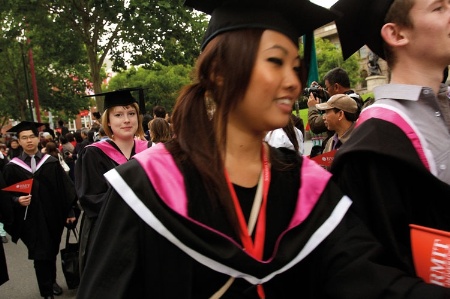
‘There are few policy or funding levers to ensure we meet the needs of the economy’
It is important to bear in mind that the demand-driven system in Australia was introduced under a dual-policy framework: the key objectives were to boost economic and social development through the provision of high-quality higher education. Along with uncapping enrolments, targets were set to increase the proportion of the population with bachelor’s degrees and to improve participation by educationally disadvantaged groups. Early indications are that we are on track to increase the proportion of 25- to 34-year-olds with a bachelor’s degree. The participation of students from lower socio-economic backgrounds has also shown some improvement, although across the sector results are mixed. Just two years on from full implementation, however, it is too early to fully assess the impact.
One criticism of the demand-driven system, ironically, is that it is simply driven by student demand. While our sector can now be more responsive to new opportunities and to addressing skills gaps, there are few policy or funding levers to ensure that we systematically meet the needs of the economy. Given that funding is driven by inputs (where funding follows the student) alone, it is unlikely that the growth seen across the sector in the past two years can be reasonably attributed to economic and skill trends. Indeed, early indications are that growth in student numbers has somewhat plateaued, and what some providers have positioned as “innovative” offerings are simply competitive behaviours to increase their market share.
I believe that if we were to revisit the implementation of a demand-driven system, there would need to be a sharper focus on student retention and outcomes. Outcomes are almost wholly lost in the current demand-driven system’s funding model: institutions are able to simply expand their intake to compensate for student attrition. But student outcomes should be at the heart of our operational model as universities.
The final watchword is to note that Australia’s demand-driven system, as currently constructed, represents an open-ended funding commitment by government. In the current fiscal environment, and indeed in any reasonable fiscal environment, this is unsustainable. The other extreme – as in my experience of the Irish equivalent system – was one in which funding per student steadily diminishes as a (shrinking) fixed-pie budget is distributed over an increasing student base year on year, and this is equally unsustainable.
Meeting demand is a laudable intent. But perhaps it would be better to set and maintain an internationally competitive budget for higher education – one that assures a level of base funding that can underpin the international standing and quality of the sector and the delivery of quality education for the student body it serves.
David Lloyd is vice-chancellor and president of the University of South Australia. He was previously bursar and director of strategic innovation at Trinity College Dublin.

‘We must adapt to new numbers and types of students’
“MORE will mean WORSE,” screamed Kingsley Amis from the pages of Encounter magazine in 1960. And then a generation of university-educated baby boomers proved him wrong.
The massive growth in universities worldwide since 1945 has been consistently met with similar cries of horror. With more students, standards will fall, some argue – and so will the value of the credential.
This has also been a criticism levelled at Australia’s uncapped system, which has led some universities to accept many more students. Academics have told me they have seen the “worst” students of their career. They say student numbers have grown enormously, as has the number of administrative staff, and university teachers are having to cope with a bigger cohort of more “difficult” students, with fewer resources.
While this is broadly true of academic experience, more than 65 years of significant growth in higher education shows that standards need not fall as numbers expand. In the 1940s, when universities in New South Wales removed Latin as a requirement for admission, standards did not fall – but some teaching approaches had to change. They still do.
Nor will tertiary education become less valuable. Universities became less elite in the 20th century, but also became more important. To maintain this importance, we must adapt to new numbers and types of students. It is the challenge for the 21st century. Some Australian universities already face it better than others.
It is important we all do this and do it well. Young Australians use post-school education to “class” themselves. This perpetuates hierarchies that help no one, and certainly not the economy. High socio-economic status students dominate high-status degrees. Low socio-economic status students are over-represented in sub-diploma courses when we need them to become more skilled.
Higher education’s potential to help address other social issues is also at stake. The further you live from the centre of a major Australian city and the darker your skin, the less likely you are to attend university. This causes long-term problems in rural Australia and the outer suburbs of cities. Education can break cycles of unemployment and helps to address health and welfare concerns. Yet many young people still find universities alien and out of reach.
It is a problem that universities have had to work on through each phase of expansion. In 1946, the botanist and educator Eric Ashby argued: “Suppose we manage a real equality of opportunity in Australian education. We still have to make the university a place worth coming to.”
Expansion and inclusion through uncapping places can help to show all students that higher education is for them. We in universities just need to make it true.
Hannah Forsyth is a historian in the Social Inclusion Unit at the University of Sydney. She is currently writing a book entitled Knowing Australia: a History of the Modern University.
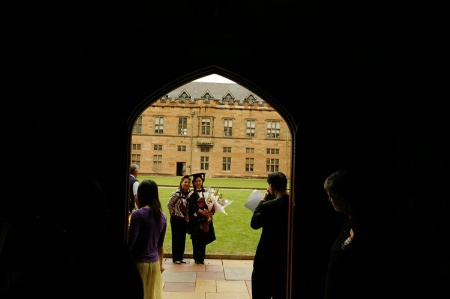
‘The government yielded to vocational providers’ concerns’
Having been a part of the UK higher education scene for many years before my departure to Australia, I have found it fascinating to observe the policy discourse from a distance. In particular, the removal of the cap on student numbers in England appears to have caught folk by surprise.
But one of the skills of university management is to simply get on with things. In truth, market principles have been affecting UK higher education for a number of years now – they are a force that is reshaping the sector, just as much as the drive towards internationalisation. Thus, Australia’s higher education landscape was not altogether unrecognisable when I joined Murdoch two years ago.
I’d like to highlight one relatively unforeseen issue arising from the uncapping of student numbers, relating to sub-bachelor’s degree-level higher education places in Australia.
Murdoch has a long history of providing such places. Before its lecture halls opened in 1975, the institution announced that its criteria for entry would look beyond school-leaving qualifications. The idea behind this approach – pioneered by Murdoch and now widely adopted – was that there might be a range of enabling or preparatory programmes and non-standard pathways to university study. Headlines about university entrance standards are not always well informed; sub-bachelor’s courses hone students’ aptitude before they embark on a bachelor’s degree.
So it is surprising that a cap remains on the number of sub-bachelor’s places available to Australian universities.
The decision to uncap student places emerged from the 2008 Bradley review, but in 2011 the government yielded to vocational training providers’ “concerns expressed about their ability to maintain market share” and announced that “qualifications below bachelor degree level will be subject to annual allocations agreed between the government and each university”. It said there was a need for “sustainability” in the tertiary sector; many thought it was really about protectionism.
Part of the problem is that sub-bachelor’s places are caught up in the vexed relationship between vocational and academic education (a problem that extends well beyond Australia).
Politics complicates the matter. There are so many governments here – six states and two territories, all under the federal umbrella – that policy debates are often amplified by historic politics and divisions between Canberra – “the bush capital” – and the capital cities. Despite forming a national network, for example, institutes of technical and further education (Tafes) get support at the state level, and despite being constituted by state legislation, universities are supported federally.
In conclusion, the worst outcome of a “root and branch” review of higher education – and this will sound familiar to UK readers – is often the one that results from the cherry-picking of its ideas. Ministers take note: by attempting to introduce a one-cap-fits-all policy on university funding, you may end up with a system that suits no one.
Jon Baldwin is deputy vice-chancellor (professional services) at Murdoch University. He was previously registrar at the University of Warwick.
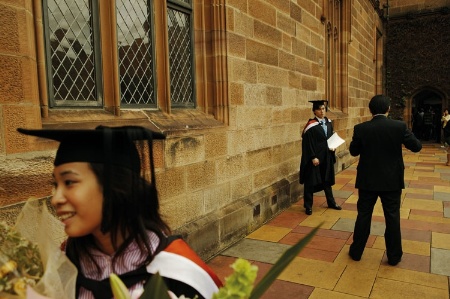
‘University planning is far too important to be left solely to market forces’
Australian universities have reacted to the uncapping of government-funded places by enrolling more and more students. “Base funding” per supported student place remains inadequate, however, despite two independent inquiries over the past five years calling for immediate increases. The result is that students are overwhelmed by the size of their classes and short-changed when pushed to communicate online with academic and administrative staff. Their performance may suffer and many give up on their studies.
The commendable objective of increasing access to university is just the first hurdle; students need to progress and succeed in gaining their degree. If they fail because of poverty, or insufficient teaching and support, it is a shameful waste: not only for the students, who still have to repay their loans, but also for the university, wider society and the nation.
With government commitment to university funding on the decline, and massive reliance on income from international student fees, class sizes have almost doubled in one generation, and half of university teaching is being done by academics employed by the hour.
Although digital communication technologies can help to enhance opportunities for pedagogical innovation, and universities are aiming to integrate their courses of study with the professional world, we are stymied in our aim of implementing exciting new curricula and offering all students the best educational experience. Course coordinators are forced to strip back and allocate to the casually employed tutor, for example, an hour of tutoring and perhaps an hour of online consultation shared among 30 students plus one hour of marking. We know that our casualised colleagues are likely to work more than their paid hours because they care about the students and hope for an academic career.
Increasingly, the quality and consistency of the Australian university system relies on unacknowledged excess time put in by both academic and general staff, more and more of whom have no job security in their roles in teaching, research or administration.
The National Tertiary Education Union maintains that university planning is far too important to be left solely to market forces. There must be coordination across the system to ensure that universities fulfil their key role in educating professional workers to meet current and future national economic and social needs. Universities should have to demonstrate that they can provide consistently high-quality education for their students, including fulfilling their obligations to those they enrol from formerly under-represented cohorts.
Uncapping can provide opportunities for more people to participate and flourish in higher education. However, the success of this initiative is critically reliant on adequate funding and staffing.
Jeannie Rea is national president of the National Tertiary Education Union, Australia.

‘Some students have been described as ill-prepared’
What has the uncapping of undergraduate university places and the demand-driven system of funding meant for Australian higher education? It has undoubtedly allowed greater access to university: an additional 190,000 students have attended university since the implementation of the policy in 2012.
The deregulation of “Commonwealth-supported” (federal government-funded) places has played a positive role in increasing participation by students from low socio-economic backgrounds, arguably greatly assisted by the national Higher Education Participation and Partnerships Program which provides funding to help universities support these students. There has been no significant improvement in participation rates for indigenous students or for those from remote areas, however, and this remains a concern.
There are other important implications. Australia’s Liberal-National coalition government has commissioned a review of the demand-led system, due to report in February. In our submission, we argued that deregulation of places may have exacerbated financial pressures in some areas of universities’ budgets, speeding up the process of pedagogical change and casualisation of teaching to deal with the extra enrolment load.
Sadly, these changes have been followed by course closures across the country, including cuts to language, music and gender studies.
Students have raised concerns with NUS Australia about the increasing casualisation of the academic workforce and emphasised the need for 21st-century infrastructure and technology, regular assessment feedback and good student support services.
In an education quality survey that we conducted in 2012 (and which will be repeated this year), students’ overall satisfaction with their courses and university was high, but there were also some worrying findings. Forty-five per cent of students reported that some or all of their lectures and tutorial rooms were overcrowded and lacked sufficient seats; only 33 per cent said they always received helpful and timely assessment feedback. Just per cent said all their lectures were recorded for online viewing, while about 16 per cent said no lectures were recorded, even though the “flipped classroom” model, with online materials supplementing interactive learning in person, may be a good way to cater for an increasingly diverse student body in an uncapped system in the years to come.
Graduate employability should be examined in more detail, and students need more information when making course and university choices in the demand-driven system. The national, government-funded MyUniversity website provides useful information, but more data on areas such as class sizes and completion rates at course level would be useful.
Since the changes, some students have been described as more ill-prepared than others, but entry scores indicate little about undergraduates’ capacity beyond their first year of study, and with the right support students can succeed and graduate having acquired the necessary skills. When we discuss “quality”, we should be talking about the quality of teaching and learning.
Funding is a crucial issue and we support the implementation of the recommendations in the 2008 Bradley review of higher education and the 2011 Higher Education Base Funding Review that recommended a desperately needed increase of 10 per cent to the federal government’s base funding for teaching and learning in higher education.
Jade Tyrrell was the 2013 national president of NUS Australia.
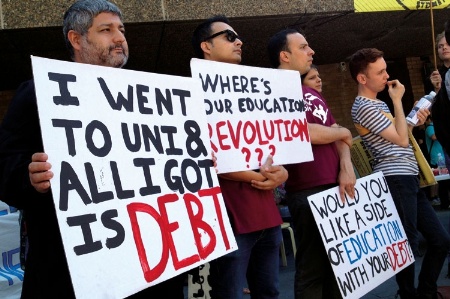
‘The deregulation of volume has enhanced pressure to deregulate fees’
Uncapping student enrolment has had three major effects in Australia. All are likely to play out in England, albeit in nationally specific ways. The two countries’ systems have always been close in structure and behaviour, even though Australia has no Oxbridge. Income-contingent tuition-fee loans and the uncapping of places increase the similarities.
First, open-ended funding is fiscally risky for the Treasury and thus such a policy will always be provisional. In Australia, the cap may come back on. The Australian Treasury restrained costs by opting not to implement expected increases in the rate of government subsidy of places in 2009, and then by cutting subsidies in 2012. The main growth occurred in the first year of uncapped places and in the year before that. In some universities, undergraduate numbers rose by 20 to 50 per cent. Numbers are now growing more slowly. In an uncapped system, growth is constrained not by regulated limits on student places, by fee levels (when tuition loans are repaid on an income-contingent basis, fees are only a modest deterrent) or by academic standards, but by limits to the supply of students completing school.
Second, open-ended recruitment changes the shape of the system. Lower-status institutions in Australia opted for growth. They broadened their catchments, mostly by expanding low-cost disciplines, took economies of scale and gained funding for infrastructure. Most research-intensive universities refused growth or grew quite slowly. The funding rate for domestic students, set by government, provides them with little incentive to grow. International students are a more attractive proposition, however, as their tuition fee levels are determined by individual universities. Thus, the uncapping of places enhances stratification and mission differentiation, which is something that most governments want whether they admit it or not – although arguably a US-style Carnegie classification would do this more effectively.
Inevitably, the deregulation of volume in Australia enhanced pressures from the elite end of the sector for the deregulation of tuition fees. The unresolved question is whether uncapped fees would be subsidised by the government through the income-contingent student loans system. This would further push up the total cost to the Treasury.
Third, uncapping has brought in a new layer of students, many less well prepared than their peers and some of them from lower socio-economic backgrounds, although there has been little overall change in the socio-economic mix. Most disciplines at most universities have stepped up academic support. It is too early to talk about optimal approaches, but programmes in which universities engage with secondary students before their entry to higher education can strengthen aspirations as well as skills. There is much concern about standards but, as usual, no evidence on trends. It is difficult to sort the problem of underprepared students from the problems of underfunding and growing class sizes. As in every expansion since the 1980s, the growth in academic staff has failed to keep pace with the growth in student numbers.
Simon Marginson is professor of international higher education at the Institute of Education, University of London. Between 2006 and 2013 he was professor of higher education at the University of Melbourne.
Caps on: changing parameters for undergraduate enrolments
2008
A review of Australian higher education led by Denise Bradley, former vice-chancellor of the University of South Australia, reports. The Bradley review recommends that Australia introduces a demand-led system of higher education, with the abolition of student quotas and traditional “block” funding, opting instead for “a funding system that is driven by demand from students”. It also recommends setting a number of targets. At least 40 per cent of 25- to 34-year-olds should possess a bachelor’s qualification by 2020, while enrolments by students from low socio-economic groups should rise to 20 per cent by the same date.
2012
Following a gradual relaxation of controls on student numbers, the policy of fully uncapped domestic student numbers is implemented.
July 2013
The new Labor higher education minister, Kim Carr, hints that he will consider reimposing numbers caps on undergraduate admissions amid concerns about quality.
September 2013
Tony Abbott’s conservative Liberal-National coalition wins elections, ending six years of Labor rule.
October 2013
Christopher Pyne, Australia’s new education minister, says that his top priorities for higher education include a review of the demand-driven undergraduate system. Critics accuse the new government of reneging on pre-election promises to preserve the country’s demand-driven system.
February 2014
The review of the demand-driven funding system is due to report.
Register to continue
Why register?
- Registration is free and only takes a moment
- Once registered, you can read 3 articles a month
- Sign up for our newsletter
Subscribe
Or subscribe for unlimited access to:
- Unlimited access to news, views, insights & reviews
- Digital editions
- Digital access to THE’s university and college rankings analysis
Already registered or a current subscriber? Login




